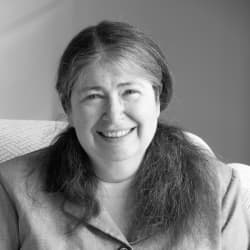 Credit: JGI/Tom Grill / Tetra Images / Getty Images
Credit: JGI/Tom Grill / Tetra Images / Getty Images
Computer science offers high-paying career opportunities as an in-demand industry. However, a large gender gap persists despite the promising job outlook.
The Pew Research Center reports that women comprised just 25% of the computing workforce in 2019, yet they make up 47% of the workforce. Women also earned only 21.3% of the computer and information sciences bachelor's degrees in the United States in 2019-2020, according to the National Center for Education Statistics.
Learn about some of the most innovative women in computer science and their valuable contributions to the field.
What Makes These Women Important to Computer Science?
Our list below highlights some of the most influential women in computer science. Their contributions helped advance the industry and foster greater gender diversity in computer science.




Women in Computer Science
Our list includes some of the ten most influential women in computer science. It highlights some of the women who made important discoveries, broke barriers, or accomplished "firsts" in the computer science field within the last 75 years.

Radia Perlman is a computer programmer and network engineer born in 1951. As one of the most influential women in computer science, she still works in the field as of 2022.
Her important contributions to computer science include spanning tree protocol, a technology that changed the way networks communicate with each other. Perlman also wrote two computer science textbooks and taught at the University of Washington and Harvard University. She has received more than 80 patents throughout her career.
She earned bachelor's and master's degrees in math from the Massachusetts Institute of Technology (MIT), later completing a Ph.D. in computer science in 1988.
In recognition of her accomplishments, she received a lifetime achievement award from the Association for Computing Machinery's special interest group on data communications.
Grace Hopper helped create the first computer compiler and numerous computer programming languages.
In the 1930s, she earned a master's degree and Ph.D. in mathematics from Yale University. She joined the U.S. Naval Reserve during World War II and worked on a computation project for the Bureau of Ships at a Harvard lab.
She continued working at Harvard after the war, focusing on applied physics and engineering sciences. She went on to work for private companies and helped create and popularize COBOL (common business-oriented language), the first standardized computer language for general business.
President George H.W. Bush awarded Hopper the National Medal of Technology in 1991, making her the first woman to receive this honor as an individual.
In recognition of her importance to the computer science field, she posthumously received the Presidential Medal of Freedom in 2016.
As a Black woman in STEM in the 1930s, Katherine Johnson broke gender and race barriers to become one of the most influential women in computer science. She demonstrated a talent for math from a young age and graduated from West Virginia State College with degrees in mathematics and French in 1937.
In 1953, Johnson got a job at the National Advisory Committee on Aeronautics, the precursor to the National Aeronautics and Space Agency (NASA). She was assigned first to work on an all-woman team analyzing flight data.
In 1962, she performed the calculations for John Glenn's Friendship 7 orbital flight. She also did some calculations for the Apollo 11 and Apollo 13 missions and continued working at NASA until 1986.
Johnson is one of the women profiled in the book, "Hidden Figures," which was later adapted into an Oscar-nominated film. In recognition of her importance to STEM, Johnson received numerous awards, including the National Medal of Freedom in 2016.
Born in 1913 in Ohio, Sister Mary Kenneth Keller joined the Sisters of Charity of the Blessed Virgin Mary in 1932. Keller became the first woman in the United States to earn a Ph.D. in computer science in 1965, after previously earning degrees in math and physics from DePaul University.
She also completed graduate work at other universities, including at Dartmouth College's computer lab, which typically excluded women at that time. While at Dartmouth, Keller helped develop the BASIC programming language, which made coding more accessible to people in fields beyond math and science.
After graduating with her Ph.D. from the University of Wisconsin Madison, she founded the department of computer science at Clark University in Iowa and remained there for about 18 years. Keller worked to attract more women to the computer science field and invited students to bring their children to class.
Born in 1989, Joy Buolamwini is a Black computer scientist and researcher at MIT. She is the founder of the Algorithmic Justice League, which focuses on making tech more equitable and accountable. She is also on the Global Tech Panel, advising governments around the world on using AI technology appropriately.
She holds a master's degree and Ph.D. in media arts and sciences from MIT. Her groundbreaking graduate thesis discusses gender and racial basis in artificial intelligence technology at companies like Amazon, Microsoft, and IBM. She describes herself as a "poet of code" and writes about AI in the popular press.
She has received recognition for her role as one of the most influential women in computer science, including being named as one of Forbes' 30 Under 30, MIT Tech Review's 35 under 35, and Fortune's World's 50 Great Leaders. More than 1.4 million people viewed her 2017 TED talk on algorithmic bias.
One of the most famous women computer scientists, Annie Easley worked for NASA and its precursor for more than three decades. She started her career in 1955 as a "human computer," crunching numbers for researchers.
Later, when technology made human computers unnecessary, Easley became a computer programmer. She developed code used in energy-related research that led to the development of batteries for early hybrid vehicles. While working full time, Easley earned a mathematics degree from Cleveland State University in the 1970s.
As a Black woman working in STEM starting in the 1950s, Easley faced racial and gender barriers. She spoke of her experience for NASA's Speakers Bureau, inspiring other women and people of color to pursue STEM careers.
Easley also became an equal employment opportunity counselor, working with supervisors to resolve complaints of gender, racial, and age discrimination in the workplace.
As a leader in computer science and data science, Jeannette Wing focuses on security and privacy, trustworthy artificial intelligence, formal methods, and programming languages.
She is the first Asian American and first woman to serve as executive vice president for research at Columbia University and teaches computer science at the school. Previously, she worked in high-level positions for Microsoft, Carnegie Mellon University, and the National Science Foundation.
Her influential essay, "Computational Thinking," successfully argues for using computer science and algorithmic thinking to solve problems in other fields. Her work is credited for influencing K-12 schools and colleges worldwide to incorporate computational theory into their curricula.
Wing holds a Ph.D. in computer science from MIT, where she also earned bachelor's and master's degrees. In 1983, she and several other women co-authored the report "Barriers to Equality in Academia: Women in Computer Science at MIT."
In recognition of her importance to the computer science field, Wing holds awards from the Association for Computing Machinery and Computing Research Association.
Margaret Hamilton played a key role in helping astronauts land on the moon. Creator of the term "software engineer," Hamilton was one of the first computer software programmers.
She earned a bachelor's degree in mathematics from Earlham College in 1958. After graduating, she got a job at MIT to help support her family while her husband attended law school. While there, she taught herself programming and created software to aid in predictive meteorology.
In the late 1960s and early 1970s, she wrote code for the onboard software that made Apollo missions to the moon possible. She was the first computer programmer and woman that NASA hired to work on the Apollo project.
She received the Presidential Medal of Freedom in 2016 from President Barack Obama to acknowledge her role in the Apollo moon missions. LEGO immortalized her and a few other NASA women by creating figurines of their likenesses in 2017.
An entrepreneur, tech leader, and engineer, Megan Smith, made history as the first woman to serve as chief information technology officer for the United States in 2014. She earned a bachelor's and master's degree in mechanical engineering from MIT.
Her work includes advocating for greater diversity in the tech field. While working at the White House, Smith created a website for women in STEM and spoke in favor of net neutrality. During this time, she also launched the Computer Science for All initiative.
Smith also filled other high-level tech roles, including vice president of Google and CEO of PlanetOut. She founded and served as CEO of shift7, a company focused on finding tech solutions to social, economic, and environmental problems.
Smith sits on the MIT board in a lifetime appointment. She also works as a member of the National Academy of Engineering and Council on Foreign Relations.
Born in 1945 in Ohio, Adele Goldberg liked math from an early age. She earned a bachelor's degree in math from the University of Michigan and worked at IBM in the summer between her junior and senior years.
While at IBM, Goldberg taught herself to program unit record machines and began considering a career in computing. In 1973, she completed a Ph.D. in information science from the University of Chicago.
After graduating, she started working at Xerox's Palo Alto Research Center, where she helped develop Smalltalk, an object-oriented programming language. Smalltalk was one of the first programming languages that could create graphic user interfaces like menus, icons, and windows.
Goldberg co-founded ParcPlace Systems and later created a consultancy group. From 1984-1986, she served as president of the Association for Computing Machinery. In 1990, Goldberg won a lifetime achievement award from PC Magazine.
Common Questions About Influential Women in Computer Science
-
Which groups are underrepresented in tech?
A 2014 U.S. Equal Employment Opportunity Commission report found that women, African Americans, and Hispanic and Latino/a Americans are underrepresented in tech. Men fill 80% of all executive roles in tech.
-
Who was the first female computer scientist?
Many people call Lady Ada Lovelace the first female computer scientist. Around 1843, Lovelace wrote what computer historians consider the first computer program.
-
How many women are in computer science?
Women comprised just 25% of the computing workforce in 2019. Female students earned 21% of all computer and information sciences bachelor's degrees in the U.S. in 2019-2020.
-
Who is the most famous woman in computer science?
Ada Lovelace, known as the first female computer scientist, is likely the most famous woman in the field.
Page last reviewed on December 5, 2022

 Reviewed by
Reviewed by